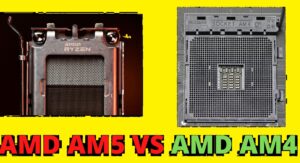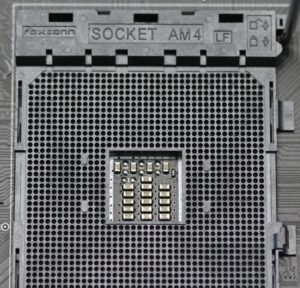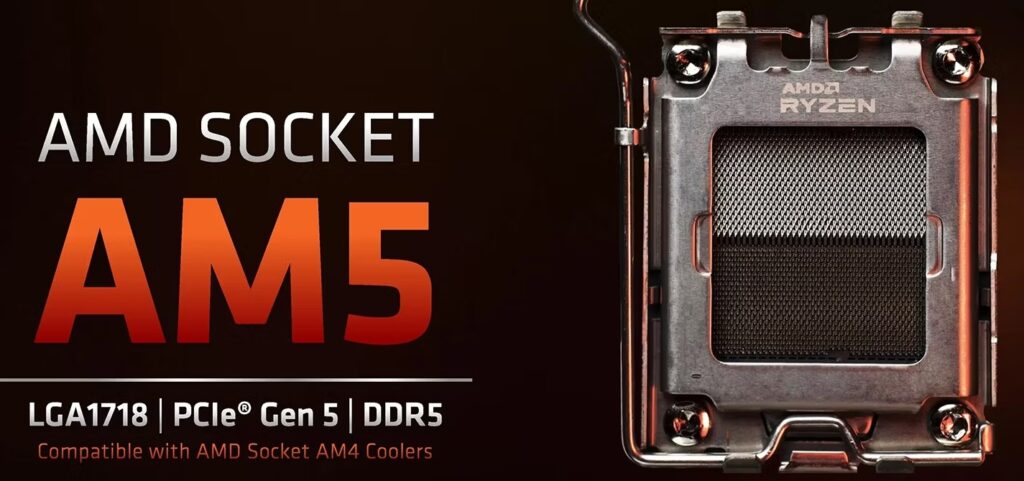Hello readers welcome to the new post. Here we will learn AM4 vs AM5: A Detailed Comparison | How To Choose Between? In the development of computer hardware, the use of processor sockets is good for PC builders or enthusiasts. The use of introduction of the AM5 socket has replaced the use of the AM4 socket. In this post, we will learn the detailed differences between AM4 and AM5, and learn which one is best. So let’s get started with AM4 vs AM5: A Detailed Comparison
Introduction of AM4 vs AM5
The development of new technologies in processor architecture and design has changed the computer structure The use of AM5 sockets has made the next level of progress in desktop processors and helping engineers to make comparisons with the older model which is the AM4 socket.
AM4 Introduction
The AM4 socket, manufactured by AMD, has become the preferred component due to its high level of working for computers since its release date. it can be used with the Ryzen 1000 to 5000 series are types of CPU. While the AM4 socket has a high value of versatility. It is used by gamers, content creators, and professionals, that is best for handling different workloads.
AM5 Introduction
There an advanced level of platform is given by AMD for their users with the introduction of the AM5 socket. The AM5 socket is supported by the Ryzen processors and comes with a developed structure and good features.
Performance and Compatibility
These two modules have their features in terms of performance. The AM4 can support the different CPUs and is famous for its good performance. The AM5 Sokcet is a high-level performance module that comes with good single and multi-thread operations for different uses.
in case of compatibility, the AM4 socket is still used for differnt processors, making it a good option for those looking to upgrade without buying a new motherboard.
Future-Proofing and Upgradability
PC uses have a main feature that is Future-proofing. The AM4 socket performed well with different generations of CPUs and provided upgradation with time. However, the AM5 sockets is a new processor that comes with advanced features
Read more Difference Between CPU and GPU
Power Efficiency and Thermal Design
Power efficiency is good for computing, and has effects on energy use and operation. The AM5socket provides teh refined power management and thermal design, providing god efficiency than its older versions.
Overlocking
Overclocking is to get work from the system rather than its capacity. The AM4 socle is considered to be an important supporter the overlocking and the AM5 socket also can handle this feature
Motherboard and Peripheral Compatibility
The socket option is not just CPu but also the motherboard and other connected devices. AM4 and Am4 have their own motherboards and chips that have different features and connections
Gaming and Multithreaded Workloads
Gaming and multithreaded workloads require different features of a CPU. The AM4 socket can work in both conditions and provides a well-rounded experience. The AM5 socket, with its good performance, could excel in these areas, used for gamers and content creators.
Memory Support and Bandwidth
Memory support and bandwidth are the main features that come with different operations on larger datasets. The AM4 socket comes with robust memory support and the AM5 socket increases this feature, offering smooth operation and data-based projects.
Integrated Features and Technologies
The latest processors have integrated features and techniques that increase user experience. Both AM4 and AM5 sockets supported different features, such as PCIe 4.0 support, USB-C, and good connectivity points
Advantages and Disadvantages of AM4
Pros:
- it can support the different CPUs
- It comes with a good ecosystem of motherboards and peripherals
- good for gaming
Cons:
- it will not be used in the future with the invention of new technology
- New processors are not compatible with this module
Advantages and Disadvantages of AM5
Pros:
- DDR5 Memory Support
- PCIE 5.0 Supported
- it increases teh power delivery
Cons:
- it supported limited CPU
- Compatibility with existing motherboards can be limited
How to Choose Between AM4 and AM5
The use of AM4 and AM5 is based on needs. If you are working on a system that needs differnt types of compatible CPUs, AM4 is the best option. If anyone needs to increase modern techniques in CPU technology and wants a larger CPU selection, AM5 can be used
So the selection of AM4 and AM5 is based on performance, compatibility, and future upgradation. Every socket has its benefits and disadvantages so use anyone according to the requirements
am4 vs am5 socket
- AM4 socket comes with a PGA pinout which means pins in this module exist on the CPU instead of the socket. While AM5 hs LGA pinut configuration that means pins are on socket configured than CPU. The LGA category of pins is best since it has less damage
- DDR4 memory unit is supported by the AM4 and AM5 supported teh DDR5 memory types. DDR5 is high speed for data transfer and comes with high bandwidth as compared to DDR4
- The artictures of CPUs like Zen3 and Zen4 are supported by the AM4 while Zen5 is supported by the AM5. Zen4 is less advanced than Am5
- AM5 supported the PCIe 5 and AM4 supported teh PCIe4. The bandwidth offered by the PCIe 5 is double that of PCIe4 so PCIe 5 is a high-speed and high-performance option
AMD socket type
AMD has used different types of sockets for their processors at different times. Some are explained here
- 754 Socket: it is an older type of socket and is used for AMD Athlon 64 and Sempron processors.
- Socket 939: it is employed for Athlon 64 X2, AMD Athlon 64, and Athlon 64 FX processors.
- AM3: it is compatible with AMD Phenom II, Athlon II, and Sempron processors, and also supports the DDR3 memory
- FM2+:Latest type of FM2 supported new APUs.
- AM4: it was invented in 2016, and used for Ryzen desktop processors, Athlon processors, A-series APUs, Supported DDR4 memory, and PCIe Gen 3/4.
- AM3+: it is the latest type of AM3 with good power handling and backup support
- TR4 (TR4): it is made for AMD’s high-end desktop (HEDT) Threadripper processors with CPU cores and PCIe lanes.
- AM2: used for Athlon 64 X2 AMD Athlon 64 and has DDR2 memory support.
- AM2+: it is the latest version of AM2, supports the AM2 processors, and has good power delivery
- TRX4 (sTR4X): advanced type of TR4, supported the 3rd generation of Threadripper processors.
- SP3: it is employed for AMD EPYC server processors, supporting larger core counts and memory channels.
- FM1: Used for AMD’s A-series APUs
- FM2: it is an updated type of FM1, used or 2nd generation AMD A-series APUs.
Is am5 compatible with am4
No, AM5 does not have compatibility with AM4. AM5 is AMD’s latest socket design, and it has differnt new features that are not supported by the AM4 CPUs. These changes are
- AM5 has a Land Grid Array (LGA) design, while AM4 uses a Pin Grid Array design.
- AM5 CPUs need higher power than AM4 CPUs, and AM5 motherboards come with a robust power-providing system
- . AM5 is supported DDR5 memory, while AM4 supports DDR4 memory.
AM4 vs AM5: Architecture
AM4 and AM5 are 2 different socket structures from AMD for their desktop CPUs. AM4 was used in 2016 and was compatible with Zen and Zen+ architectures. AM5 was used in 2022 and supported the Zen 4 architecture.
comparing the architecture of AM4 and AM5
| Feature | AM4 | AM5 |
|---|---|---|
| CPU architecture | Zen and Zen+ | Zen 4 |
| Cores | 16 | 16 |
| higest clock speed | 5 Gigahertz | 5.5 gigahertz |
| TDP | 142W | 230 W |
| Memory support | DDR4-3200 | DDR5-5200 |
| PCIe compatibility | PCIe 4 | PCIe 5.0 |
AM5 vs AM4: Worth the Upgrade?
The upgrade from AM4 to AM5 is important based on need and budget. If anyone is finding the best functions from a desktop CPU then AM5 is best. AM5 offers the latest functions than AM4
For the best performance in a desktop CPU, AM5 is a good choice. AM5 has made CPU architecture, a larger number of cores high clock speeds, larger memory support, and PCIe 5.0 compatibility
AM5 is also more costly than AM4. AM4 is best if your budget is less or not want to upgrade
AM4 CPUs also have feteus to support AMD for different years.
pros and cons of upgrading from AM4 to AM5:
| Pros | Cons |
|---|---|
| Good performance | Expensive |
| latest CPU architecture | it requires a new motherboard and memory |
| High clock speeds | Not compatible with AM4 CPUs |
| larger cores | |
| larger memory support | |
| PCIe 5.0 supported |
What’s New in the AM5 Platform
The AM5 platform is AMD’s latest socket made of desktop CPUs. It was used in 2022 and supported Zen 4 architecture.
Here are some features of the AM5 platform:
- Zen 4 architecture: The AM5 platform is compatible with Zen 4 architecture, which is AMD’s latest and most recent CPU architecture. Zen 4 has more advanced features than older Zen 3 architecture, such as a new core design, a new cache design, and the latest memory controller.
- LGA socket: it also employs a Land Grid Array (LGA) socket, which is different from the Pin Grid Array (PGA) socket work by the AM4 platform.
- DDR5 memory: It is supported the DDR5 memory, which it the latest version of memory technology. DDR5 provides double the bandwidth of DDR4 memory, so it is preferred for memory-intensive projects.
- PCIe 5.0 support: it also supported PCIe 5.0, which is advanced in PCIe standards. PCIe 5.0 provides double the bandwidth of PCIe 4.0, which is best for high-bandwidth applications like gaming and video editing.
AM4 vs AM5 – How do Features Compare?
- AM5 is the first AMD socket that supports DDR5. Contrary to Intel new Z690 and Z790 chipsets, the AM5 socket does not have a DDR option.
- Like the new chipsets of intel, AM5 supported PCIe Generation 5 within expansion slots also M.2 ports.
- The higher TDP support feature does not affect more components or devices but affects net operation for future AM5 processors. By supporting about 230W total power AM5 processors can provide higher frequency and total core count than older modules.
Is AM5 compatible with AM4?
Is AM4 dead?
Is AM4 and AM5 same cooler?
Can AM4 run DDR5?
- What is CPU: Full Form of CPU, Working, Types, Parts & Applications
- Introduction to the Central Processing Unit (CPU) of PLC
- ATMega328p Pinout Configuration, Features & Datasheet [A Quick Guide]
- Advanced Console Output Techniques in C++
- MSI Boot Menu Key And How To Access It
- 10 Best Motherboard for Ryzen 7 5800x IN 2023
FAQs
Is AM5 better than AM4?
Yes, AM5 is better than AM4 for features and performance. It supported the PCIe 5.0 standard, which is two times faster than PCIe 4.0. It also supports DDR5 memory, high speed then DDR4 memory. AM5 motherboards come with more features and good power delivery than AM4 motherboards.
Is AM5 compatible with AM4?
AM5 is not supported by AM4. The 2 sockets are not physically supported, and AM5 motherboards needed CPUs with the latest AM5 socket.
Is Ryzen 5 AM4 or AM5?
Ryzen 5 CPUs come in both AM4 and AM5 types. The Ryzen 5 5600X is an AM4 CPU, while the Ryzen 5 7600X is an AM5 CPU.
Are AM4 and AM5 the same size?
N AM4 and AM5 do not have the same size. The AM4 socket is 40mm square, while the AM5 socket is 50mm square.
Can AM5 use DDR4?
No, AM5 motherboards supported DDR5 memory.
Is Ryzen 7 5800X AM4 or AM5?
The Ryzen 7 5800X is an AM4 CPU. It is not compatible with AM5 motherboards.
What are the benefits of AM5?
The advantages of AM5 are:
-
Compatible with PCIe 5.0
-
DDR5 memory supports
-
Larger features and good power delivery are future-proof
-
Is AM4 outdated?
AM4 is not outdated, but it is not considered the latest socket. AM5 is the latest socket from AMD, and it has different benefits than AM4. If you are making a new PC, use the AM5 motherboard.
- How long did AM4 last?
AM4 lasted for 4 years, from 2017 to 2021. It was the longest-lasting socket from AMD.









